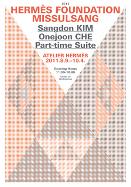
FONDATION D’ENTREPRISE HERMÈS
Prix Émile Hermès
Competition Theme
HEAT, ME-HEAT, RE-HEAT
Since its inception in 2007, the Prix Émile Hermès has supported innovation and promoted the work of talented young designers whose forward-looking, sustainable approach reflects our evolving society and lifestyles. For the second Prix Emile Hermès, the Fondation d’entreprise Hermès has chosen a universal theme touching on one of humanity’s most vital needs: to heat, me-heat, re-heat.
The mastery of heat has been a challenge for mankind throughout the ages. The emergence of the first constructed hearths, some 400,000 years ago, marked the beginnings of human society as we know it. Firelight prolonged the day and held back the night, while the heat of the fire extended summer into winter, allowing men to settle the planet’s temperate and cold regions. The hearth was a source of warmth, fostering better living conditions, providing more hygienic, cooked food and improved methods for the manufacture of tools. Last but not least, the warm, radiant hearth promoted social interaction, communal living, and the rise of modern man.
Closely connected with technological progress, the mastery of fire brought great leaps forward in the 19th and 20th centuries, in the generation, preservation and uses of heat. Mankind has reached beyond the Titan Prometheus, learning how to make the heat we need, for ourselves. By combustion, of course, but also friction, fusion, fission, or the mixing of chemical components... Man has also learned to harness natural, environmental energy sources, through insulation, by constructing dwellings above stables, and latterly through the mastery of geothermal energies, bio-gas, solar and wind power, the rivers and tides.
OBJECTS DESIGNED TO HARNESS HEAT.
Over the centuries, mankind has shown extraordinary ingenuity, finding new ways to produce energy, and creating new objects designed to "heat, me-heat, re-heat’’. The applications and uses of heat are endless. From the highly sophisticated to the extremely simple, each object is intrinsically linked to its geographical and economic context, and the lifestyles of its users. Whether for heating, cooking, hygiene and sterilisation, medical or sporting functions, heat plays a role in every aspect of human social and economic interaction.
KEY ISSUES ON A GLOBAL SCALE
From the most basic methods of generation to the most highly technological, heat is the focus of continuous research, a major geopolitical issue linked to the control of energy resources, and a fundamental, vital force touching humanity as a whole. "Heat, me-heat, re-heat" - the theme of the second Prix Emile Hermès - implies a fresh perspective on contemporary lifestyles and energy use, a practical, long-term approach to related design issues, and a recognition of the principles of sustainable development, with the ultimate aim of reducing the planetary "footprint" of the human race, soon to number some 8 billion individuals. The jury of the Prix Émile Hermès will invite entrants to take account of these multiple issues in their submissions.
Design Specification
A SUSTAINABLE, LASTING DESIGN
Candidates are invited to submit designs for an object, machine, utensil, piece of furniture, architectural concept etc., carefully devised and formulated for a specific, practical function while at the same time proposing a formal, aesthetic concept of the highest quality. Each design will offer a lasting, sustainable alternative to existing everyday objects performing the functions stated in the competition’s theme. Multi-purpose, adaptable designs are also invited, incorporating uses and applications which may be discovered over the life the object.
INGENIOUS SOLUTIONS SHOWCASING AN ECONOMY OF MEANS
The submitted designs will offer ingenious solutions for practical, effective objects made using basic techniques and a simple, reliable production process, while at the same time devising unprecedented, wholly modern procedures. Modernity in simplicity: state-of-the-art techniques may be used, but with an emphasis on simple, user-friendly solutions rather than technological complexity.
A SUSTAINABLE APPROACH AND PROCESS
Candidates will offer detailed explanation and justification of their choice of production process, taking account of key environmental issues (notably the required energy sources, avoiding the use of non-renewable natural resources). The production process should aim to limit the object’s environmental footprint as far as possible, notably through the use of locally-available resources. Each entry will include a detailed energy audit, and an analysis of the object’s life cycle.
A PRACTICAL, REPRODUCIBLE OBJECT
Each object, machine, utensil etc. must be designed for easy reproducibility, whether conceived for the mass market and industrial manufacture, or small-scale distribution and production using traditional craft techniques. One-off, utopian designs or "dream products" are by definition excluded.
SPHERES OF APPLICATION
Designs will focus on everyday indoor or outdoor uses, indoor and outdoor spaces, and/or emergency and humanitarian applications.
Candidates may focus on one or all of the functions stated in the competition theme.
The Prix Émile Hermès does not cover fashion or clothing. Designs should in no way echo or make reference to the house of Hermès (the parent organisation of the Fondation d’entreprise Hermès), nor to its logo, brand colours or style specifications.
Key dates
September 15 – November 30, 2010: announcement of this year’s theme, registration online
December 1, 2010 – February 15, 2011: submission of projects and designs (online at prixemilehermes.com)
mid-March, 2011: jury in session to select the final shortlist, based on initial submissions
March 31, 2011: announcement of finalists
April 1 – June 30, 2011: protoypes to be delivered to the Foundation
mid-July 2011: jury in session to examine and assess the prototypes
October 2011: presentation of the awards
The dates of the jury sessions and award ceremony are subject to alteration, but will not either advance or postpone the final dates for submission of the initial online entries or, subsequently, the prototypes.


